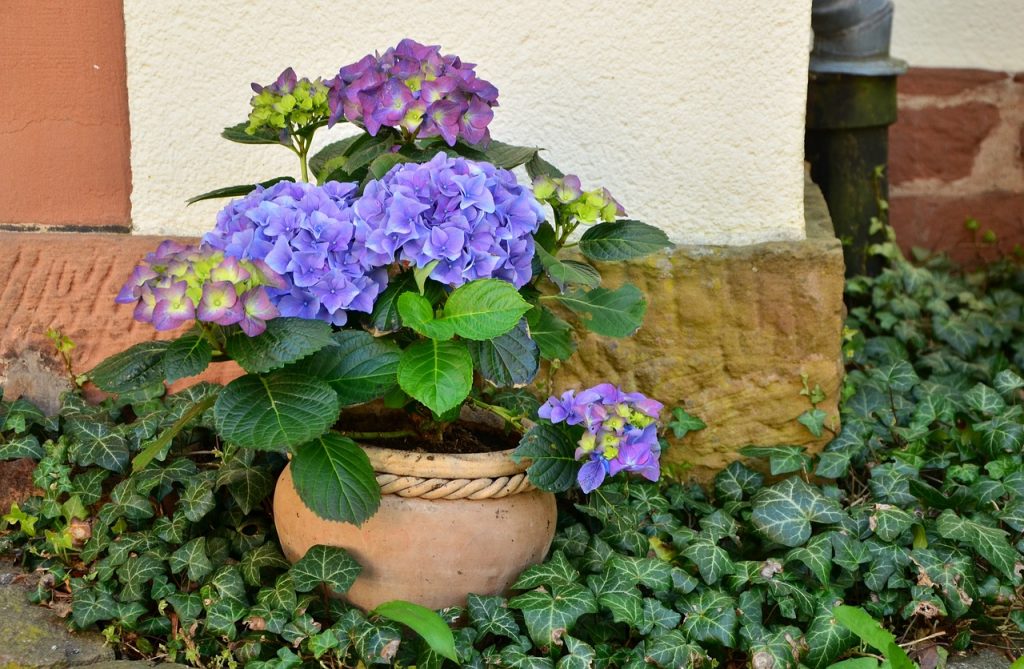Hydrangeas are also called hortensia. Hydrangeas is a Greek word that means water vessels. It is named so, because of the shape of its seed shells. Their big flower heads make them serve well as ornamental flowers. Oakleaf, bigleaf, smooth and mophead are some of the different types of hydrangeas. Moreover, some of these plants are evergreen and some are deciduous. Hydrangeas are mostly grown as shrubs and trees, but they can also be grown as climbing vines. The blooms are produced from early spring to late autumn. Fall Hydrangea are unique flowers, as the color of the flower is determined by the soil pH level. As a result hydrangeas are nicknamed, “change rose” simply because of their ability to change color. There are popular because of their beautiful exceptional flowers.
Impact of soil pH levels on hydrangeas flowers
Soil pH levels have a significant impact on hydrangeas flowers color. The pH levels in the soil causes the color in flowers to change. The color ranges from purple, blue, pink and red. Basically, acidic soil yields hydrangeas flowers that are blue or purple, whereas, alkaline soil yields flowers that are red or pink. Therefore, 5.5-6.5 soil pH level will cause the flower to be purple. Soil with a pH level of 6.5 or higher will have pink flowers and a pH level of 5.5 or lower will bring up blue hydrangeas. However, white flowers because of their lack of color pigment are the only hydrangeas that do not change color because of the soil pH levels.
Factors to consider when planting hydrangeas
When planting hydrangeas, you have to know the type of soil they require, the right time to plant them, where to plant and lastly how to plant them. With that knowledge at the tip of your hands, you are guaranteed to have a flourishing garden with beautiful blooms. The perfect time to plant hydrangeas is in fall and early spring. This will give the shrubs a lot of time to develop healthy roots before they bloom. You should plant them when the weather is cooler preferably early in the morning or late in the afternoon to protect them from heat stress.
It is significant that you know where to plant them. Hydrangeas do well in a sheltered place that offers warm morning sun and shady afternoons. They don’t do well under afternoon heat. The sheltered place should be able to protect the plants from strong winds. Strong winds destroy the flowers and damage the leaves.
Fall blooming hydrangea thrive in soil that has plenty of organic material. The organic matter adds more nutrients to the soil which makes it healthy for the plants. They also do well in moist soil with good drainage system. When planting the holes have to be 2-3 feet wide than the root ball and there should be spaced at least 3-10 feet apart.
Caring for Hydrangeas

Watering
Hydrangea care, you should make sure the soil is moist at all times not saturated. Hydrangeas thrive in well-drained moist soil. During the course of the growing period, you should water at a rate of 1 inch per-week. To promote root growth, you should water at least 3 times a week. Different types of hydrangeas require different amounts of water. For example, smooth hydrangeas and bigleaf need more water than others. How to care for hydrangea, it is important that when you are watering you water deeply. When watering you also have to ensure that none of the water goes onto the leaves or flowers. Hydrangeas are easy to tell when they want water. The leaves start to wilt which shows that the plant is getting dehydrated. It is advisable that if you want to prevent wilting in summer, you should water your plants in the morning.
To maintain the soil moist and to keep it cool at all times, you have to add mulch. Hydrangea fallcare, you have to ensure that you put mulch to protect hydrangeas plants when there is frost. Additionally, mulch also improves the soil texture and adds more nutrients into the soil.
Hydrangea Fertilizer
Each hydrangea has different requirements and different application timing. For example, smooth hydrangeas require you to apply fertilizer once in winter and bigleaf requires you to put fertilizer frequently in March, May and June. Basically, you don’t have to put fertilizer if your soil is rich. Putting a lot of fertilizer does not cause hydrangeas to bloom, instead it promotes leafy growth. You should use 10-10-10 fertilizer because it is good for all types of hydrangeas. Most importantly, you should test your soil regularly to identify its fertility needs.
Pruning hydrangea tree
How to care for a hydrangea? You can care for your hydrangeas by pruning them once a year especially when the new leaf buds start to show. Failure to prune occasionally will cause the bush to become too leggy. This causes the weight of the stems to become too great for the plant to carry. This will result in the stems sagging and breaking.
Some hydrangeas only flower on old wood. Therefore, pruning old wood is not ideal as it will cause them not flower for that period till the new wood turns old. However, pruning is not necessary if the hydrangeas have plenty of growing space. How do you take care of hydrangeas? I take care of hydrangeas by occasionally removing dead wood and flowers.
Pests and diseases
You should choose hydrangeas that are resistant to diseases. Care for hydrangea, hydrangeas require utmost care so that plants do not get stressed. Pests like red spider mites and slugs are more likely to attack your plants when there are stressed. You should take proper care to protect them from diseases like leaf spots and ringspot virus.
Uses/symbolism
- In Japan, they use the leaves to make herbal tea
- In flower language, pink hydrangeas mean, “you are the beat of my heart”
- They symbolize kindness and appreciation for being understood
Conclusion
Hydrangeas flowers are exceptionally beautiful and colorful. There are unique, as they can have all the colorful colors blooming on the same plant. The flowers also come in a range of sizes and shapes. The Hydrangea color of the flowers is largely determined by the soil pH level. With proper care and the right conditions, these ornamental plants are easy to grow and maintain.

Leave a Reply